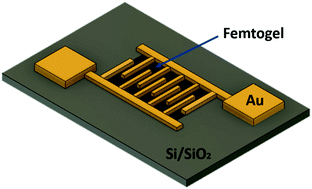High-responsivity reduced graphene oxide gel photodetectors for visible-light detection with a large detection area and an end-contact interface†
Abstract
Herein, the engineering and characterization of a photodetector using reduced graphene oxide gel (femtogel) as an active material are reported for the first time. The photodetector is engineered such that it contains a large detection area (interdigitated) and a femtogel–metal interface. The femtogel film is precisely placed between the interdigitated electrodes, which allows us to study the performance of the photodetector that has an end-contact interface. The femtogel width (channel) is controlled by adjusting the reactive ion etching processing time during the fabrication process. In addition, the thickness of the poly(methyl methacrylate) (PMMA) and electron-beam dose during the lithography process plays a significant role in initializing a window for etching the femtogel, which affects the channel width. In the visible range, a high responsivity has been achieved as high as 0.73 A W−1 at a low power intensity of 84 mW cm−2. Moreover, 3.4 s and 5.2 s are recorded as the time response of the photocurrent for growth and decay, respectively, in the proposed femtogel photodetector. This could open a new avenue for the fabrication of graphene-based photodetectors since placing graphene and its derivatives that are in liquid form between electrodes in a nanoscale detector is still a challenge in advanced nanofabrication.



 Please wait while we load your content...
Please wait while we load your content...